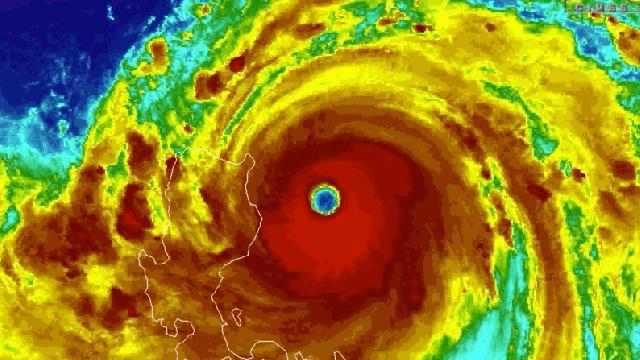While the world watches Florence make a historic landfall in the Carolinas, there’s another storm on the other side of the planet worthy of our attention. Super Typhoon Mangkhut is the biggest, baddest storm on the planet, and it’s bearing down on the Philippines’ most populous island.
After ripping apart houses in Guam like tin cans, Mangkhut — known as Ompong in the Philippines, which uses a different typhoon naming system — has continued its westward march across the Pacific. The storm is packing wind gusts up to 324km/h, taking the title from Super Typhoon Jebi for the strongest cyclone to grace our fair planet this year. Tropical storm-force winds radiate roughly 483km out from its centre.
Mangkhut made landfall early Saturday morning in the northeast corner of Luzon, an island that’s home to 43 million. The huge wind field means that even Manila, located 400km south, could still feel the impacts of Mangkhut.
But those in the direct vicinity of Mangkhut’s landfall will have to contend with much more than that. The storm could produce 6m of storm surge according to the Red Cross, creating deadly conditions along the coast.
The Philippines meteorological service warned that all evacuations should already have taken place and that the “situation is potentially very destructive”. The group notes that trees could be uprooted, coconut plantations could be destroyed, and that the electrical system and homes and commercial buildings are likely to see “severe” damage.
Mangkhut has drawn comparisons to Super Typhoon Haiyan, which is a really ominous sign. That storm tore through the Philippines in 2013, leaving 6000 dead and obliterating entire communities. Mangkhut, however, isn’t quite as strong and is forecast to take a more northerly path through the island nation, passing over a less densely populated region.
While there hasn’t been any work to attribute Mangkhut specifically to climate change, the warmer oceans and higher seas that are both hallmarks of our warming world are clear links. Mangkhut is passing over waters that are up to 1.5C above normal, providing the fuel it needs to stay strong. The Philippines is also a sea level rise hot spot, with waters rising five times faster than the global average.
The Philippines is also a hot spot for typhoons owing to its tropical location. The nation has been hit by more tropical cyclones than any other country save China since 1970.
